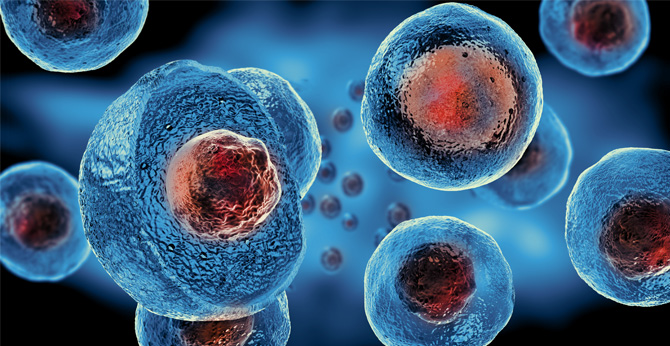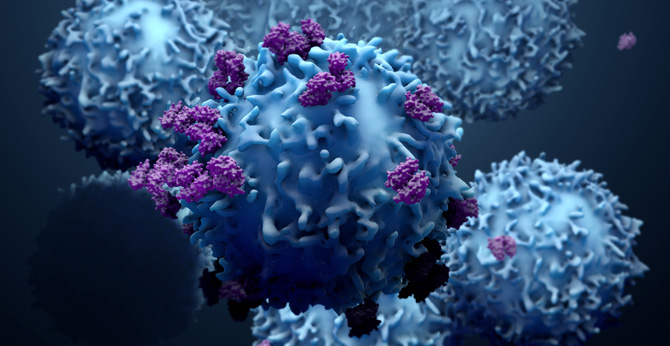All products and services are For Research Use Only and CANNOT be used in the treatment or diagnosis of disease.
Neural cell adhesion molecule (NCAM), also called CD56, is a homophilic binding glycoprotein expressed on the surface of neurons, glia, skeletal muscle and natural killer cells. NCAM has been implicated as having a role in cell–cell adhesion, neurite outgrowth, synaptic plasticity, and learning and memory. NCAM is thought to signal to induce neurite outgrowth via the fibroblast growth factor receptor (FGFR) and act upon the p59Fyn signaling pathway. Tumors that are CD56-positive are myeloma, myeloid leukemia, neuroendocrine tumors, Wilms' tumor, neuroblastoma, NK/T cell lymphomas, pancreatic acinar cell carcinoma, pheochromocytoma, paraganglioma, small cell lung carcinoma, and the Ewing's sarcoma family of tumors. NCAM has been used as a target molecule for experimental antibody-based immunotherapy. Successful radioimmunolocalisation of metastases was demonstrated after giving injections of NCAM-binding 123J-UJ13a or 131J-UJ13a radioimmunoconjugates to children with neuroblastoma. Patients with small cell lung cancer were treated with the anti-NCAM immunotoxine huN901-DM1 in two different clinical studies, revealing acceptable toxicity and signs of clinical response.
 Associated Disease
Associated Disease Loading...
Loading...
| CAT | Product Name | Target Species | Antibody Clone | Antibody Host | Receptor Construction | Vector Type | Targeting Cell Type | CAR Vector Type | Inquiry & Datasheet |
| XS-0822-YF726 | Anti-Mouse CD56 (XW-726) m(41BB-CD3ζ) CAR IVT Plasmid, pCARIVT | Mouse | XW-726 | Mouse | scFv-41BB-CD3ζ | In Vitro Transcription (IVT) Vector | |||
| XS-1122-LX183 | Anti-CD56 (X11X183) h(CD28-41BB-CD3ζ) CAR, pCDCAR1 | Human | X11X183 | Humanized | scFv-CD28-41BB-CD3ζ | Lentiviral vector | T cell | ||
| XS-1122-LX184 | Anti-CD56 (X11X184) h(CD28-41BB-CD3ζ) CAR, pCDCAR1 | Human | X11X184 | Humanized | scFv-CD28-41BB-CD3ζ | Lentiviral vector | T cell | ||
| XS-1122-LX185 | Anti-CD56 (X11X185) h(CD28-41BB-CD3ζ) CAR, pCDCAR1 | Human | X11X185 | Humanized | scFv-CD28-41BB-CD3ζ | Lentiviral vector | T cell | ||
| XS-1122-LX573 | Anti-CD56 (X11X175) h(CD28-OX40-CD3ζ) CAR, pCDCAR1 | Human | X11X175 | Humanized | scFv-CD28-OX40-CD3ζ | Lentiviral vector | T cell | ||
| XS-1122-LX574 | Anti-CD56 (X11X176) h(CD28-OX40-CD3ζ) CAR, pCDCAR1 | Human | X11X176 | Humanized | scFv-CD28-OX40-CD3ζ | Lentiviral vector | T cell | ||
| XS-1122-LX575 | Anti-CD56 (X11X177) h(CD28-OX40-CD3ζ) CAR, pCDCAR1 | Human | X11X177 | Humanized | scFv-CD28-OX40-CD3ζ | Lentiviral vector | T cell | ||
| XS-1122-LX576 | Anti-CD56 (X11X178) h(CD28-OX40-CD3ζ) CAR, pCDCAR1 | Human | X11X178 | Humanized | scFv-CD28-OX40-CD3ζ | Lentiviral vector | T cell | ||
| XS-1122-LX577 | Anti-CD56 (X11X179) h(CD28-OX40-CD3ζ) CAR, pCDCAR1 | Human | X11X179 | Humanized | scFv-CD28-OX40-CD3ζ | Lentiviral vector | T cell | ||
| XS-1122-LX578 | Anti-CD56 (X11X180) h(CD28-OX40-CD3ζ) CAR, pCDCAR1 | Human | X11X180 | Humanized | scFv-CD28-OX40-CD3ζ | Lentiviral vector | T cell | ||
| XS-1122-LX579 | Anti-CD56 (X11X181) h(CD28-OX40-CD3ζ) CAR, pCDCAR1 | Human | X11X181 | Humanized | scFv-CD28-OX40-CD3ζ | Lentiviral vector | T cell | ||
| XS-1122-LX580 | Anti-CD56 (X11X182) h(CD28-OX40-CD3ζ) CAR, pCDCAR1 | Human | X11X182 | Humanized | scFv-CD28-OX40-CD3ζ | Lentiviral vector | T cell | ||
| XS-1122-LX581 | Anti-CD56 (X11X183) h(CD28-OX40-CD3ζ) CAR, pCDCAR1 | Human | X11X183 | Humanized | scFv-CD28-OX40-CD3ζ | Lentiviral vector | T cell | ||
| XS-1122-LX582 | Anti-CD56 (X11X184) h(CD28-OX40-CD3ζ) CAR, pCDCAR1 | Human | X11X184 | Humanized | scFv-CD28-OX40-CD3ζ | Lentiviral vector | T cell | ||
| XS-1122-LX583 | Anti-CD56 (X11X185) h(CD28-OX40-CD3ζ) CAR, pCDCAR1 | Human | X11X185 | Humanized | scFv-CD28-OX40-CD3ζ | Lentiviral vector | T cell | ||
| XS-1122-LX971 | Anti-CD56 (X11X175) h(ICOS-4-1BB-CD3ζ) CAR, pCDCAR1 | Human | X11X175 | Humanized | scFv-ICOS-4-1BB-CD3ζ | Lentiviral vector | T cell | ||
| XS-1122-LX972 | Anti-CD56 (X11X176) h(ICOS-4-1BB-CD3ζ) CAR, pCDCAR1 | Human | X11X176 | Humanized | scFv-ICOS-4-1BB-CD3ζ | Lentiviral vector | T cell | ||
| XS-1122-LX973 | Anti-CD56 (X11X177) h(ICOS-4-1BB-CD3ζ) CAR, pCDCAR1 | Human | X11X177 | Humanized | scFv-ICOS-4-1BB-CD3ζ | Lentiviral vector | T cell | ||
| XS-1122-LX974 | Anti-CD56 (X11X178) h(ICOS-4-1BB-CD3ζ) CAR, pCDCAR1 | Human | X11X178 | Humanized | scFv-ICOS-4-1BB-CD3ζ | Lentiviral vector | T cell | ||
| XS-1122-LX975 | Anti-CD56 (X11X179) h(ICOS-4-1BB-CD3ζ) CAR, pCDCAR1 | Human | X11X179 | Humanized | scFv-ICOS-4-1BB-CD3ζ | Lentiviral vector | T cell |
 NEWSLETTER
NEWSLETTER
The latest newsletter to introduce the latest breaking information, our site updates, field and other scientific news, important events, and insights from industry leaders
LEARN MORE NEWSLETTER NEW SOLUTION
NEW SOLUTION
CellRapeutics™ In Vivo Cell Engineering: One-stop in vivo T/B/NK cell and macrophage engineering services covering vectors construction to function verification.
LEARN MORE SOLUTION NOVEL TECHNOLOGY
NOVEL TECHNOLOGY
Silence™ CAR-T Cell: A novel platform to enhance CAR-T cell immunotherapy by combining RNAi technology to suppress genes that may impede CAR functionality.
LEARN MORE NOVEL TECHNOLOGY NEW SOLUTION
NEW SOLUTION
Canine CAR-T Therapy Development: From early target discovery, CAR design and construction, cell culture, and transfection, to in vitro and in vivo function validation.
LEARN MORE SOLUTION